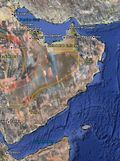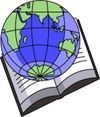HonestReporting's social media editor, Alex Margolin, contributes occasional posts on social media issues. He oversees HonestReporting on Facebook.
 With over 600 million downloads, Google Earth is quickly becoming the most widely used – and most important – world map on the planet. Together with its other prominent mapping program, Google Maps, Google has managed to stamp its own distinctly Web 2.0 sensibility on the field of cartography.
With over 600 million downloads, Google Earth is quickly becoming the most widely used – and most important – world map on the planet. Together with its other prominent mapping program, Google Maps, Google has managed to stamp its own distinctly Web 2.0 sensibility on the field of cartography.
While Google Maps is used primarily for finding street directions, Google Earth combines state-of-the-art satellite imagery with user-generated content to create something much bigger. Users can zone in on virtually any part of the world. And contributors can add notes to geographic locations on one of the sites' numerous “layers.” The result is a new Internet-based approach to mapping known as “neogeography.”
Israelis got a taste of this new phenomenon in 2008, when Palestinian activist Thareen Darby began labeling Israeli towns sites of Arab expulsion during the Israel’s War of Independence. Eventually, residents of Kiryat Yam sued Google for libel after Darby added their city to his list.
According to journalist John Gravois, who examined Google’s impact on the mapping world in an article for the Washington Monthly, Google’s approach to international disputes, particularly over geographic names, has ruffled many feathers.
 Gravois cited one dispute between Iran and the Arab world over what to call the body of water traditionally known as the Persian Gulf. In 2008, Google accepted the relatively new Arab claims to the name Arabian Gulf, placing the name alongside the UN-backed Persian Gulf moniker. In response, Iranians launched a petition calling for the “immediate and unconditional deletion of ‘Arabian Gulf’ from Google Earth.” The petition gathered 1,235,743 signatures.
Gravois cited one dispute between Iran and the Arab world over what to call the body of water traditionally known as the Persian Gulf. In 2008, Google accepted the relatively new Arab claims to the name Arabian Gulf, placing the name alongside the UN-backed Persian Gulf moniker. In response, Iranians launched a petition calling for the “immediate and unconditional deletion of ‘Arabian Gulf’ from Google Earth.” The petition gathered 1,235,743 signatures.
Google, however, refused to back down. As Gravois explains:
Google responded to the debate with a rather novel set of cartographic norms, throwing all historical criteria out the window. Two months after the “Immediate and Unconditional Deletion” petition went live, the corporation posted a statement explaining its protocol for naming bodies of water. The statement, which made no direct mention of the Gulf or the Iranian petition, explained that Google decides what to call various geographical features purely by determining what names are in use today. Google Earth “displays the primary, common, local name(s) given to a body of water by the sovereign nations that border it,” wrote Andrew McLaughlin, Google’s then director of public policy (and now President Obama’s deputy chief technology officer). “If different countries dispute the proper name for a body of water, our policy is to display both names.”
Displaying “both names,” as McLaughlin wrote, eliminates the need to take sides in a dispute but rarely leaves both sides happy. And despite the democratic aura of the policy – letting the people decide what to call something – the ultimate decision rests in one place, Google.
 And while the policy may be ripe for abuse, a bigger problem is the loss of authority. Increasingly, it is harder to consult the biggest map in the world for a definitive answer to a geographic question. Indeed, in an interview on the radio show, On the Media, Gravois noted that the definition of the word "map" is beginning to change.
And while the policy may be ripe for abuse, a bigger problem is the loss of authority. Increasingly, it is harder to consult the biggest map in the world for a definitive answer to a geographic question. Indeed, in an interview on the radio show, On the Media, Gravois noted that the definition of the word "map" is beginning to change.
It’s almost like we shouldn't use the word “map” any more. It’s a completely different thing. It’s a completely re-scalable document that can hold authoritative information but it can also have other layers of information that are just sort of repositories of a bunch of different opinions, or even conversations. That’s neat, and it may play a really huge, valuable social role in the future. But the process of adjusting to that new norm is going to be really, really hairy.
So if online maps are moving in the new direction of neogeography, the key is to move along with them to ensure that all points of view are expressed. Because, in the increasingly collaborative Internet world, participation is the coin of the realm.
Previously in Alex's series: Digital Diplomacy . . . And Its Discontents

